Aaron Sanchez Passes A Big Test Against The Yankees, Even If He Doesn’t Believe It
By John Lott
8 years ago
Photo Credit: Kim Klement-USA TODAY Sports
The Yankees hadn’t seen much of Aaron Sanchez, but they certainly knew the plan. If Sanchez could execute it, however, what they knew wouldn’t matter, even if their lineup did feature seven left-handed hitters. Lefties, as Sanchez and everybody else knew, had always been his chief antagonists. You could look it up, and on Tuesday, lots of beat writers were doing just that.
The strategy for Sanchez was straightforward: own the inside, especially early in the game. Bust the lefties tight with four-seam fastballs and that trademark hard sinker. Use the curveball early in the count. Mix in the changeup. Keep the hitters off balance. Don’t let them lean in and extend their hands.
And if all of that works, nudge them to expand their strike zones during the second and third times through the order.
All of it did not work, at least not sufficiently to leave Sanchez with a satisfied mind. He allowed only two runs – one earned – over six innings against the Yankees, but afterward, he gave himself a harsh evaluation. Had his teammates scored a few more runs, his assessment undoubtedly would have been less severe.
In the Blue Jays’ 3-2 loss, Sanchez allowed only three hits (all by left-handed batters). But he threw 97 pitches and fell behind in the count to 14 of the 24 batters he faced. His emotions unraveled in the second inning when he didn’t get a couple of called strikes he thought he deserved, and then he threw a pickoff attempt into centre field to set up a run.
Sanchez is 23 years old. He has made only 13 major-league starts. He is still learning. And he is beating himself up because he is still learning.
“There were a couple calls that didn’t go my way,” he said of that unruly second inning. “Obviously being in the big leagues, that’s something that shouldn’t affect you. For me, it did, and it cost us a run.”
He was also seething over his hither-and-yon pitch location.
“You can’t go out there expecting to do great when it’s ball-ball-ball-strike-strike-strike-ball-strike,” he said, referring to his inability to get ahead in the count consistently and to put batters away promptly when he did.
To wit: In the sixth inning, with a 2-1 lead, Sanchez threw a first-pitch strike to Mark Teixeira. Then he threw three straight balls, came back with a strike and got Teixeira to ground out. The fans cheered, but for Sanchez, it was an out that took too long.
Then came another critical sequence, this one fateful. He threw two straight balls to Brian McCann, then two strikes, then a ball. And then came a full-count sinker that stayed flat and ran smack-dab into McCann’s swing. The no-doubt homer tied the score, and the Yankees tallied the eventual winner the next inning against the so-far hapless Brett Cecil.
***
This start would be a steep challenge for Sanchez against a notoriously patient lineup. And the approach outlined above was far more complex than the one he used as a lockdown reliever, a role he filled for the Blue Jays over the final two months of the 2015 season and into the playoffs.
Over that stretch, as manager John Gibbons observed Tuesday afternoon, Sanchez was “just letting ‘er rip, a one-pitch guy.” That one pitch was the hard sinker – averaging 96 miles an hour, with sharp down and in movement to a right-hander, and a scary piece of business for a hitter given one at-bat to figure it out. Against Sanchez the reliever, batting left or right didn’t make much difference.
But at the beginning of last season, Sanchez had made 11 starts, and during that stretch, when he was using his full repertoire, his lefty-righty splits were stark. Right-handed batters went 18-for-112 (.161) and did not hit a homer off him. Lefties went 38-for-124 (.306) with 14 extra-base hits, including eight homers.
Sanchez added 20 pounds of muscle in the off-season and came to camp fiercely determined to earn a rotation spot. In his first start of the season, against the Rays, he allowed one run in seven innings and struck out eight. He also walked none, in contrast to his rotation stretch last year when he averaged nearly four walks per outing.
The Rays featured five lefties against Sanchez, but let’s face it, when it comes to offence, the Rays are not the Yankees, nor are they inclined to patience. So Tuesday night’s matchup was widely viewed as a key early-season test for Sanchez in his bid to fulfill his self-proclaimed destiny as front-line starter – a potential ace, in fact.
“His breaking ball looks better,” Gibbons said before the game. “That was a key for him. He’s got better command of his fastball to both sides of the plate so he can equalize the lefties a little bit more inside, keep ‘em honest a little bit. His changeup’s coming along. He’s just more of a complete pitcher.”
Sanchez has said the extra weight – he now carries 220 pounds on his 6-foot-4 frame – eases the stress of his delivery and will make him more durable.
“He’s finally turned into a man, so that’s got to help him, I would think,” Gibbons said.
***
Early on against the Yankees, the plan was working – most of it, anyway. Sanchez finished the first inning with a three-pitch strikeout of Mark Teixeira – two sinkers at 97 and a curveball, down and in, at 80. He would have escaped a two-walk second inning but for his ill-advised attempt to pick off McCann.
Someone asked: Why did you do that?
“He’s dead in the water if I make a good throw,” Sanchez replied. Temptation got the best of him, he said, when he saw the Yankee catcher “out there bouncing around.” He should’ve let him bounce.
In the third inning, Sanchez stayed inside on Brett Gardner with fastballs and curveballs, and then, on a 3-2 pitch, went to the outer half with a fastball at 95. Attuned to inside pitches, Gardner froze and took strike three.
The next batter, Alex Rodriguez, saw six pitches: two four-seam fastballs, two hard sinkers and two changeups. Sanchez blew the last pitch past A-Rod at 96 for a swinging strikeout.
There were other good at-bats, and others that generated outs but took too long against those tenacious Yankee hitters. Sanchez also lacked consistent control of his curveball; catcher Russ Martin made several extraordinary stops, including one that left him sprawled in the dirt 10 feet wide of home plate, looking for a moment like he needed a siesta.
Sanchez and pitching coach Pete Walker have been focusing on killing velocity on his changeup, to create a greater gap between its speed and that of his hard stuff. It remains a work in progress. In both of his starts, the changeup has hovered around 90, several miles per hour above the target range. In both starts, Sanchez used it sparingly.
In two starts, he has worked 13 innings and allowed two earned runs. While he was on the mound, the Blue Jays have scored a total of four runs. They lost both games by 3-2 scores.
Few pitchers would complain about those two starts. Sanchez chose to focus on the flaws, both mechanical and emotional.
“He’s the kind of kid that expects greatness out there from himself,” Martin said. “He’s probably just a little bit ticked off that he gave up the homer or something like that. But I felt like he threw a great ball game.”
Sanchez said he knows what he must work on before his next start in Fenway Park on Sunday. He did not promise greatness. But, he vowed, “I’ll be sharp.”
Recent articles from John Lott





